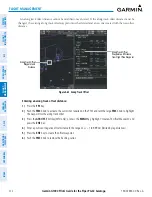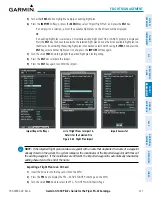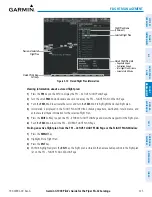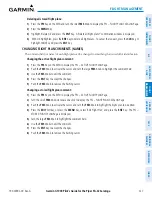
Garmin G1000 Pilot’s Guide for the Piper PA-32 Saratoga
190-02692-00 Rev. A
214
FLIGHT MANAGEMENT
SY
STEM
O
VER
VIEW
FLIGHT
INSTRUMENTS
EIS
AUDIO P
ANEL
& CNS
FLIGHT
MANA
GEMENT
HAZARD
AV
OID
ANCE
AFCS
ADDITIONAL FEA
TURES
APPENDICES
INDEX
If the parallel track proposed by the offset direction and distance is not allowed by the system, the activation
prompt is displayed, but disabled. Parallel Track cannot be activated if a course is set using direct-to or if the
active leg is the first leg of the departure procedure. Attempting to activate parallel track with these conditions
results in the message ‘Parallel Track Unavailable Invalid Route Geometry’. If an approach leg is active the
status indicates the system is unable to activate the parallel track with the message ‘Parallel Track Unavailable
Approach Leg Active’. If the offset direction and distance results in an unreasonable route geometry the status
indicates the system is unable to activate the parallel track because of invalid geometry.
If the active leg is not a track between two fixes (TF) or a course to a fix (DF) leg, the status
indicates the system is unable to activate the parallel track because parallel track is not available for the active
leg type.
Cancelling parallel track:
1)
Press the
FPL
.
2)
Press the
MENU
Key, highlight ‘Parallel Track’, and press the
ENT
Key. The PARALLEL TRACK Window is
displayed with CANCEL PARALLEL TRACK? highlighted.
3)
Press the
ENT
Key.
CLOSEST POINT OF FPL
Closest Point of FPL calculates the bearing and closest distance at which a flight plan passes a reference
waypoint, and creates a new user waypoint along the flight plan at the location closest to a chosen reference
waypoint.
Determining the closest point along the active flight plan to a selected waypoint:
1)
Press the
FPL
Key.
2)
Press the
MENU
Key, highlight ‘Closest Point Of FPL’, and press the
ENT
Key. A window appears with the
reference waypoint field highlighted.
3)
Enter the identifier of the reference waypoint and press the
ENT
Key. The system displays the bearing (BRG) and
distance (DIS) to the closest point along the flight plan to the selected reference waypoint and creates a user
waypoint at this location. The name for the new user waypoint is derived from the identifier of the reference
waypoint.






























